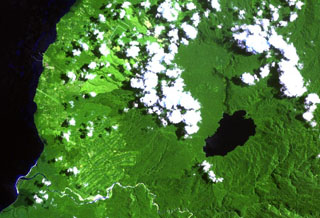Report on Hargy (Papua New Guinea) — October 1990
Bulletin of the Global Volcanism Network, vol. 15, no. 10 (October 1990)
Managing Editor: Lindsay McClelland.
Hargy (Papua New Guinea) Weak fumarolic emissions
Please cite this report as:
Global Volcanism Program, 1990. Report on Hargy (Papua New Guinea) (McClelland, L., ed.). Bulletin of the Global Volcanism Network, 15:10. Smithsonian Institution. https://doi.org/10.5479/si.GVP.BGVN199010-252100
Hargy
Papua New Guinea
5.33°S, 151.1°E; summit elev. 1148 m
All times are local (unless otherwise noted)
"Weak fumarolic emissions were noted from the SE side of the W summit crater during an overflight in early September. No unusual activity was observed."
Geological Summary. This little-known volcano is one of several major calderas on the island of New Britain. The 10 x 12 km Hargy caldera, whose floor is 150 m above sea level, contains an inner caldera with a steep west-facing wall. A caldera lake on the SE side drains through a narrow gap in the northern caldera wall. The latest caldera-forming eruption of Hargy volcano took place about 11,000 years ago. The dacitic Galloseulo lava cone rises above and partially overtops the western rim of the caldera. A double crater occupies a larger 700-m-wide crater. Numerous small eruptions have taken place at Galloseulo over the past 7000 years, the last occurring about 1000 years ago.
Information Contacts: C. McKee and I. Itikarai, RVO.

